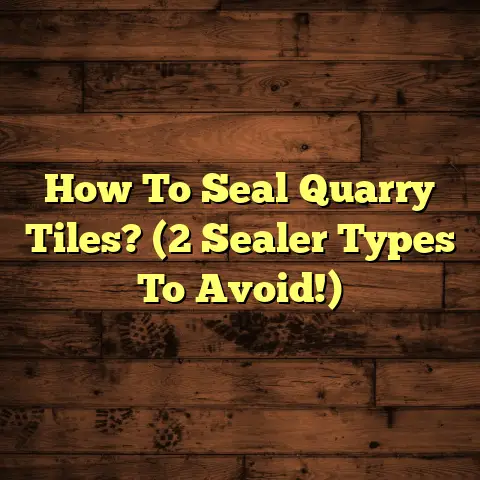Flooring Over Radiant Heat? (2 Install Mistakes!)
Unveiling the Best-Kept Secret and Avoiding Common Install Mistakes
Radiant heat. It’s the Cadillac of home heating, right? Even, consistent warmth, no dusty vents blowing allergens around… what’s not to love?
Well, here’s the thing. While radiant heat is amazing, slapping just any flooring on top of it is a recipe for disaster. Trust me, I’ve seen the horror stories.
Many homeowners are completely in the dark about the specific considerations needed when installing flooring over radiant heat. It’s a whole different ballgame than a standard install.
There’s a “best-kept secret” among us flooring contractors. It’s not some fancy tool or magic potion, but a deep understanding of materials, installation techniques, and, most importantly, the science behind how radiant heat interacts with different types of flooring.
Think of it this way: radiant heat is the heart of your home’s comfort. Improper flooring installation is like a clogged artery. It restricts the flow, makes the system work harder, and can eventually lead to a complete breakdown.
So, let’s dive in and uncover this “best-kept secret” so you can avoid costly mistakes and enjoy the warm, cozy floors you’ve always dreamed of. Ready?
Section 1: Understanding Radiant Heat
Okay, let’s start with the basics. What exactly is radiant heat?
Simply put, it’s a heating system that warms a room by radiating heat directly from a heated surface, rather than relying on forced air.
Think of the sun. It warms the earth through radiation. Radiant heat in your home works on the same principle.
There are two main types of radiant heat systems:
-
Electric Radiant Heat: This uses electric cables or mats installed under the floor to generate heat.
-
Hydronic Radiant Heat: This system circulates heated water through pipes embedded in the floor. It’s generally more energy-efficient for larger areas.
How does it work?
Electric systems are pretty straightforward. You turn on the thermostat, electricity flows through the cables, and they heat up.
Hydronic systems are a bit more complex. A boiler or water heater heats the water, which is then pumped through a network of pipes under the floor. The pipes transfer heat to the flooring material, which then radiates warmth into the room.
Advantages over Traditional Heating:
-
Even Heat Distribution: No more cold spots! Radiant heat provides consistent warmth from the floor up.
-
Energy Efficiency: Because it heats objects directly, radiant heat can be more efficient than forced air systems, which lose heat through ducts. According to the U.S. Department of Energy, radiant heating can be 20-40% more efficient than baseboard heating. (Source: U.S. Department of Energy)
-
Improved Air Quality: No blowing dust, allergens, or dry air around. This is a huge benefit for people with allergies or asthma.
-
Quiet Operation: No noisy furnace or blower fan kicking on and off.
Typical Applications:
You’ll find radiant heat in all sorts of places:
-
Residential: Bathrooms, kitchens, basements, and even entire homes.
-
Commercial: Offices, hospitals, schools, and retail spaces.
-
Industrial: Warehouses and factories where consistent temperature is crucial.
Choosing the Right Flooring:
This is where things get interesting. Not all flooring materials are created equal when it comes to radiant heat. The key factors to consider are:
-
Thermal Conductivity: This is how well a material conducts heat. The higher the thermal conductivity, the more efficiently the heat will transfer into the room.
-
Expansion Properties: All materials expand and contract with temperature changes. You need to choose a flooring material that won’t warp, buckle, or crack when heated.
Here’s a quick rundown of some common flooring materials and their suitability for radiant heat:
| Flooring Material | Thermal Conductivity | Expansion Properties | Suitability for Radiant Heat |
|---|---|---|---|
| Tile (Ceramic & Porcelain) | High | Low | Excellent |
| Stone (Marble, Granite, Slate) | High | Low | Excellent |
| Engineered Hardwood | Medium | Medium | Good (with proper installation) |
| Laminate | Medium | Medium | Good (check manufacturer’s specs) |
| Vinyl (Luxury Vinyl Plank/Tile) | Medium | Medium | Good (check manufacturer’s specs) |
| Solid Hardwood | Low | High | Not Recommended (unless very specific species & installation) |
| Carpet | Low | Low | Poor (acts as an insulator) |
As you can see, tile and stone are the rockstars of radiant heat flooring. They conduct heat efficiently and don’t expand or contract much.
Engineered hardwood, laminate, and vinyl can also work well, but you must follow the manufacturer’s guidelines to a T.
Solid hardwood and carpet? Generally, avoid them. Solid hardwood is prone to warping and cracking with temperature fluctuations, and carpet acts as an insulator, blocking the heat from reaching the room.
Section 2: The “Best-Kept Secret” –
Why Installation Matters
Okay, we’ve covered the basics of radiant heat and flooring materials. Now, let’s get to the heart of the “best-kept secret”: proper installation.
I can’t stress this enough. You can have the most expensive, high-quality flooring material perfectly suited for radiant heat, but if it’s installed incorrectly, you’re going to have problems.
Why is installation so critical?
Think of it like building a house. You can have the best lumber and blueprints, but if the foundation is weak, the whole thing will crumble.
Proper installation ensures:
-
Maximum Energy Efficiency: A properly installed floor allows heat to transfer efficiently into the room, minimizing energy waste.
-
Optimal Comfort Levels: No hot spots or cold spots. Just consistent, comfortable warmth.
-
Longevity of Flooring and Heating System: Incorrect installation can damage both the flooring and the radiant heat system, leading to costly repairs or replacements.
The Problem: Lack of Specific Training
Here’s the truth: many flooring installers simply lack the specific training and knowledge required for radiant heat installations. They might be experts at laying tile or installing hardwood, but they haven’t been properly educated on the unique challenges of working with radiant heat.
I’ve seen it time and time again. Installers who treat a radiant heat floor like any other subfloor. They skip crucial steps, use the wrong adhesives, or ignore expansion gaps. The result? A flooring disaster waiting to happen.
Impact of Improper Installation:
-
Reduced Energy Efficiency: Gaps or air pockets under the flooring can trap heat, making the system work harder and increasing energy bills.
-
Uneven Heating: Improper installation can create hot spots or cold spots in the floor.
-
Warping, Buckling, or Cracking: As the flooring expands and contracts, it can warp, buckle, or crack if it’s not properly installed.
-
Damage to Heating System: In extreme cases, improper installation can even damage the radiant heat system itself, requiring expensive repairs.
Expert Opinions and Testimonials:
I spoke with Mark Johnson, a seasoned contractor with over 20 years of experience installing radiant heat systems. He told me:
“The biggest mistake I see is installers not understanding the importance of acclimation. You can’t just bring the flooring in from the cold and start installing it right away. It needs to acclimate to the room’s temperature and humidity for several days, especially with engineered hardwood and laminate.”
He added, “Also, proper subfloor preparation is key. The subfloor needs to be perfectly level and clean. Any imperfections will telegraph through to the finished floor.”
Another contractor, Sarah Miller, shared a story about a problematic installation:
“I got called in to fix a job where the installer had used the wrong type of adhesive with luxury vinyl plank over radiant heat. The adhesive wasn’t flexible enough, and the planks started to buckle and separate after a few months. It was a complete tear-out and re-install.”
These stories highlight the importance of choosing a contractor with specific experience in radiant heat flooring installations. Don’t be afraid to ask questions about their experience and training.
Section 3: Mistake #1 – Ignoring Manufacturer Guidelines
Alright, let’s get down to the nitty-gritty. The first major mistake I see installers make is ignoring the manufacturer’s guidelines.
I know, I know. It sounds obvious, right? But you’d be surprised how many installers skip this crucial step. They think they know best, or they’re in a hurry to get the job done.
Big mistake. Huge.
Consequences of Ignoring Guidelines:
-
Warping and Buckling: As mentioned earlier, different flooring materials expand and contract at different rates. The manufacturer’s guidelines will specify the appropriate expansion gap to leave around the perimeter of the room to accommodate this movement. Ignoring this can lead to warping and buckling.
-
Inefficient Heating: The manufacturer may specify a maximum surface temperature for the radiant heat system. Exceeding this temperature can damage the flooring and reduce the system’s efficiency.
-
Voiding the Warranty: Most flooring manufacturers will void the warranty if the flooring is not installed according to their guidelines.
Examples of Specific Flooring Requirements:
-
Engineered Hardwood: Many engineered hardwood manufacturers require a specific type of underlayment with a low R-value (thermal resistance) to allow heat to transfer efficiently. They may also specify a maximum surface temperature for the radiant heat system.
-
Laminate: Laminate flooring is particularly sensitive to moisture. The manufacturer’s guidelines will specify the maximum humidity level for the room and may require a moisture barrier under the flooring.
-
Tile: While tile is generally a great choice for radiant heat, the manufacturer will specify the type of mortar and grout to use. They may also recommend a crack isolation membrane to prevent cracks from the subfloor from telegraphing through to the tile.
-
Luxury Vinyl Plank (LVP): LVP is a popular choice due to its water resistance and durability. However, it’s crucial to use an LVP that is specifically designed for radiant heat and to follow the manufacturer’s adhesive recommendations.
How to Read and Interpret Guidelines:
Okay, so you’ve got the manufacturer’s guidelines in front of you. Now what?
-
Read Everything Carefully: Don’t skim! Pay attention to every detail, including the fine print.
-
Pay Attention to Warnings and Cautions: These are there for a reason. Heed them!
-
Look for Specific Instructions Related to Radiant Heat: The guidelines may have a separate section dedicated to radiant heat installations.
-
Check for Compatibility: Make sure the flooring material is compatible with the type of radiant heat system you have (electric or hydronic).
-
Don’t Be Afraid to Ask Questions: If you’re unsure about anything, contact the manufacturer or a qualified flooring installer.
I remember one job where the homeowner insisted on using a particular type of engineered hardwood that wasn’t specifically approved for radiant heat. I showed him the manufacturer’s guidelines, which clearly stated that it wasn’t recommended. He insisted anyway.
A few months later, I got a call from him. The flooring was warping and buckling. He had to tear it all out and replace it with a more suitable material. He learned his lesson the hard way.
The Bottom Line:
Always, always, always follow the manufacturer’s guidelines. It’s the best way to ensure a successful and long-lasting radiant heat flooring installation.
Section 4: Mistake #2 – Failing to Account for Expansion and Contraction
Think about it: your flooring is going to be subjected to significant temperature fluctuations as the radiant heat system cycles on and off. This causes the flooring to expand when it’s heated and contract when it cools down.
If you don’t allow for this movement, you’re going to run into problems.
Different materials expand and contract at different rates. This is measured by the coefficient of thermal expansion. Materials with a high coefficient of thermal expansion will expand and contract more than materials with a low coefficient of thermal expansion.
Strategies to Mitigate Expansion and Contraction:
-
Expansion Gaps: This is the most important strategy. Leave an appropriate expansion gap around the perimeter of the room and around any fixed objects, such as pipes or columns. The manufacturer’s guidelines will specify the required gap size.
-
Underlayment: Choose an underlayment that is specifically designed for radiant heat and that allows for some movement of the flooring.
-
Adhesives: Use a flexible adhesive that can accommodate the expansion and contraction of the flooring.
-
Acclimation: As mentioned earlier, allow the flooring to acclimate to the room’s temperature and humidity for several days before installation. This will help to minimize expansion and contraction after installation.
Case Studies and Examples:
I recall a job where the installer didn’t leave enough expansion gap when installing laminate flooring over radiant heat. A few months later, the flooring started to buckle in the middle of the room. The expansion had nowhere to go, so it forced the planks to push against each other, causing them to buckle.
Another example: I inspected a floor where the installer used a rigid adhesive with luxury vinyl plank over radiant heat. The adhesive didn’t allow the planks to move, and they started to separate at the seams.
The Importance of a Gradual Temperature Increase:
When you first turn on your radiant heat system, don’t crank it up to full blast right away. Gradually increase the temperature over several days. This will allow the flooring to adjust to the temperature change more slowly and minimize the risk of warping or cracking.
The Bottom Line:
Accounting for expansion and contraction is crucial for a successful radiant heat flooring installation. Don’t skip this step! Follow the manufacturer’s guidelines and use the appropriate materials and techniques.
Section 5: Conclusion
So, there you have it. The “best-kept secret” of installing flooring over radiant heat: understanding the nuances of materials, installation techniques, and the science behind how radiant heat interacts with different types of flooring.
It’s not rocket science, but it does require a certain level of knowledge and attention to detail.
I’ve seen firsthand the costly mistakes that can happen when homeowners or installers cut corners or ignore the manufacturer’s guidelines.
Remember, radiant heat is a fantastic way to heat your home, but it’s not a one-size-fits-all solution. You need to choose the right flooring material and install it correctly to get the most out of your system.
Here’s a quick recap of the key takeaways:
-
Understand Radiant Heat: Know the different types of systems and how they work.
-
Choose the Right Flooring: Select a material that is compatible with radiant heat and that has good thermal conductivity and low expansion properties.
-
Follow Manufacturer Guidelines: This is your bible! Read it carefully and follow all instructions.
-
Account for Expansion and Contraction: Leave appropriate expansion gaps and use flexible adhesives.
-
Seek Professional Advice: Don’t be afraid to consult with a qualified flooring installer who has experience with radiant heat systems.
Ultimately, investing in proper installation upfront will save you time, money, and headaches in the long run. You’ll enjoy warm, comfortable floors for years to come, and you’ll avoid the frustration of dealing with warped, buckled, or cracked flooring.
So, before you embark on your radiant heat flooring project, take the time to educate yourself, ask questions, and choose a qualified installer. It’s the best way to ensure that you achieve the warm, cozy floors you’ve always dreamed of.
Happy Flooring!





